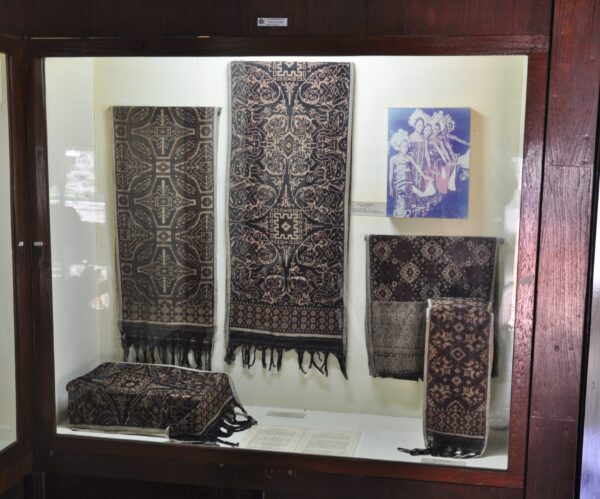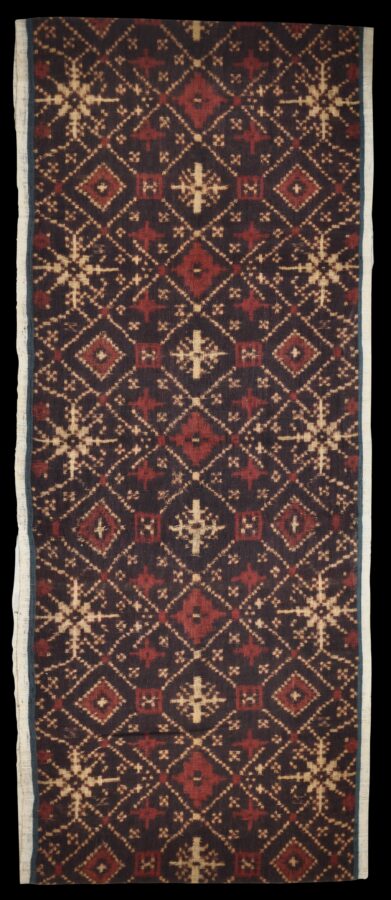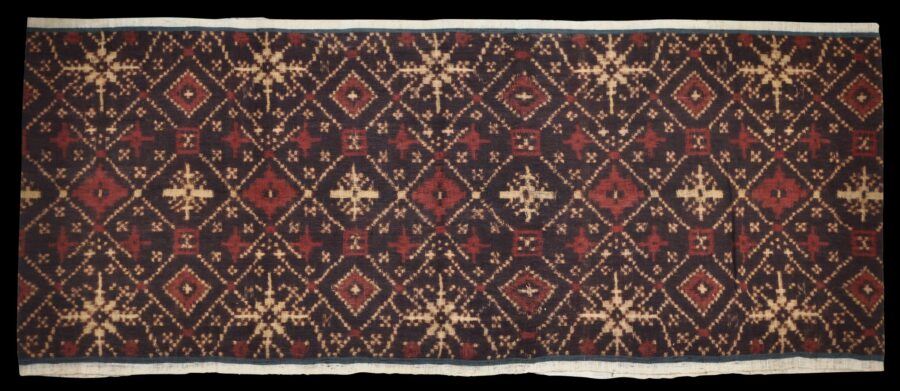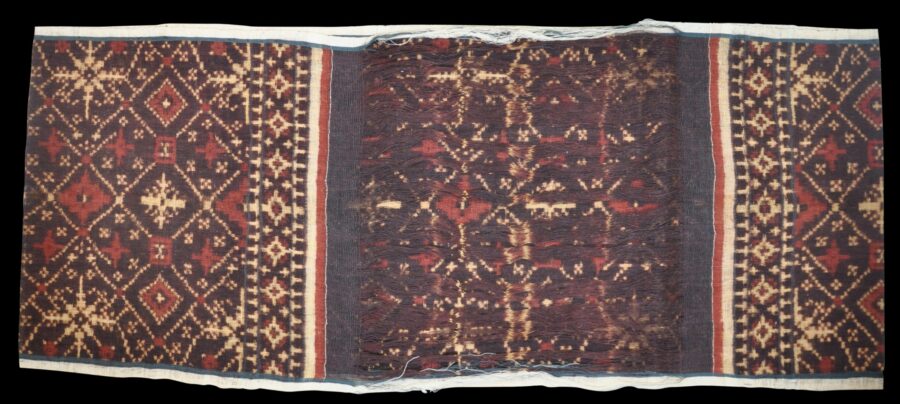Enquiry about object: 8694
Balinese Double-Ikat Geringsing Cawat Ding Ding Si Gading Cloth
Tenganan Pegeringsingan, South-East Bali, Indonesia 19th century
folded length: 105cm (full length: 210cm), width: 42.5cm
Provenance
private collection, UK; believed to have been collected in Bali in the 1920s
This fine geringsing cloth is decorated in a manner that harks back to patola trade cloths imported over the centuries from India.
Geringsing cloth is the much fabled cloth from one particular village in Bali – the village of Tenganan Pegeringsingan in south-east Bali, which is noteworthy not only for this rare cloth but for its unusual customs that sets it apart from other Balinese villages and communities. Geringsing is regarded as a sacred cloth, not just in Tenganan, but across Bali, and was widely ascribed supernatural properties, particularly in assisting with healing and even with exorcism (Guy, 2009, p. 96). The wearing of geringsing cloth both implied the wearer’s ritual purity and helped to preserve it.
The villagers of Tenganan are known as Bali Aga, or ‘original Bali’. They worship the god Indra who they honour as the creator of the first human beings and as the divine originator of their spectacular geringsing cloths. They consider themselves to be quite separate to conventional Balinese, as indeed do other Balinese. Their culture appears to be a form of pre-Majapahit Balinese culture. It is insular: the village is small and walled. Traditionally, villagers must marry within the village; those who did not were forced to live outside its walls.
Geringsing is a double-ikat cloth, meaning that it is a highly complex and laborious textile to produce, hence it was expensive even when bought new. It requires the resist dyeing of both the warp and the weft threads in such a way that when combined in plainweave they both contribute to the desired pattern. This gives rise to geringsing cloths have an almost ‘out-of-focus’ quality.
The villagers view the ability to weave geringsing as instrumental to their identification as members of the community. Traditionally, different patterns were worn for different important ceremonies. The cloth was considered to have magical properties and was revered all over Bali. The ceremonial nature of the cloth means that women are forbidden to be involved in its manufacture while menstruating.
Bolts of geringsing cloth are never wide – it is woven on narrow backstrap looms. It is made from homespun cotton and the traditional muted, rust hues of the cloth are derived from vegetable dyes, including a red dye from the roots of the noni tree (morinda citrifolia). Before dyeing the threads are soaked in a candlenut oil, wood ash and water mixture, and then laid out to dry in the sun. This process can be repeated up to twelve times to enhance the penetration of the dye. The actual weaving is a painstaking process given that the weft and the warp must be separately dyed and precisely matched.
There are around twenty different geringsing patterns; they are mainly geometric such as the example shown here, but some geringsing cloths also have floral patterns.
The cloth here follows the patola pattern – patola was a double ikat trade cloth produced in Gujarat in India, and was much sought after in Indonesia. Officials of the Dutch East India Company (VOC) realised in the early 17th century that they could pay for spices in what became known as the Dutch East Indies with certain types of colourful patola cloth produced in India. Indian patola was favoured by the nobility across Indonesia and indeed became a prerogative among many such ruling groups.
The example here remains in its original circular shape – the fringes not having been cut but remain joined. Such uncut pieces of geringsing were used to wrap deities and statues as part of religious rituals and ceremonies.
The textile here is in good condition, and is without holes, or repairs.

A display of geringsing textiles in the Bali Museum, Denpasar, Bali, Indonesia.
Scroll down for more images.
References
Barnes, R., & M. Hunt Kahlenberg (eds), Five Centuries of Indonesian Textiles: The Mary Hunt Kahlenberg Collection, Delmonico Books, 2010.
Gillow, J., Traditional Indonesian Textiles, Thames & Hudson, 1995.
Guy, J., Indian Textiles in the East: From Southeast Asia to Japan, Thames & Hudson, 2009.
Hauser-Schaublin, B., M.L. Nabholz-Kartaschoff & U. Ramseyer, Balinese Textiles, British Museum Press, 1991.
Maxwell, R., Textiles of Southeast Asia: Tradition, Trade and Transformation, Periplus, 2003.
Reichle, N. (ed.), Bali: Art, Ritual & Performance, Asian Art Museum, 2010.




